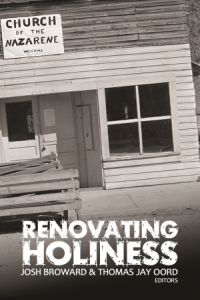Three Key Themes in Contemporary Holiness
The new Renovating Holiness book is selling very well! My co-editor, Josh Broward, and I are excited to see the myriad of ways the book is sparking new conversations about what holiness might mean today.
Renovating Holiness brings together 100+ Millennial and Xer leaders in the Church of the Nazarene to explore holiness afresh. The book is nearly 500 pages long! Already the book is being discussed on various continents by people who care about holiness.
Not only can you buy the book on Amazon in print version, but the Kindle version is now available. And bulk orders at drastically reduced prices are available through the book’s own website, www.renovatingholiness.com
My own essay in Renovating Holiness offers some summary comments meant to identify key themes that emerge in the essays. I identify ten themes. In a previous blog, I focused on three of them, and in this blog I address three more…
Community counts; relationships are relevant.
Many suggest that community and relationships are central themes for understanding what some call our postmodern age. The philosophy of modernity is often criticized for being individualistic and thinking of life as disconnected. Many now seek a relational view of reality and the essential relatedness of community.
Xer and Millennial essayists in this book stress the importance of local community, church relationships, and group accountability. Many essayists say this generation sees a strong communal component to holiness. The power of church – community relationships and the life of the tribe – is a common theme.
Some essayists capture this focus by calling for renewed emphasis upon community practices, including the sacraments and other means of grace. Such practices in community prove crucial for developing the holy life. Holiness as understood by many Xers and Millennials is far more than personal decision. With John Wesley, they seem to believe holiness is a social endeavor.
It’s more about process than crisis.
For decades, people in the holiness movement have been discussing the relative roles of crisis and process in sanctification. The discussion is nuanced and complex. But it basically comes down to whether one believes sanctification is best understood as happening in a moment of decision or through a process of growth in grace. Most people affirm both crisis and process, of course. But most either implicitly or explicitly emphasize one more than the other.
Millennials and Xers writing for this book do not resolve the process vs. crisis debate. But in their essays, the majority points more to a process or growth-in-grace understanding of holiness. They speak about continual cooperating with God, increasing in Christ-likeness, ongoing spiritual transformation. In these essays, process dominates.
In light of the emphasis among Millennials and Xers upon holiness as ongoing transformation, and in light of their lack of emphasis upon holiness as second definite work, this generation of holiness leaders might prefer the word “furtherness” instead of “secondness” when thinking about their views. Whatever the language, these essays stress the ongoing life of holiness.
Other Christians are holy too.
One way to understand the diversity within Christianity is to identify particular traditions and movements. The Church of the Nazarene is the largest organized group – denomination – emerging from the so-called “holiness movement.” Not surprisingly, the movement gets its name from its special emphasis upon holiness, although what holiness entails was and is diversely understood.
Those growing up in the holiness movement have been tempted to think the Church of the Nazarene has the corner on holiness. Judging by many essays in this book, however, Xer and Millennial leaders care also about how other Christian traditions and movements understand holiness. Many essayists call readers to appreciate the traditions, practices, and ideas of denominations other than the Church of the Nazarene.
My sense in reading these essays is that Millennials and Xers have an expansive vision of the Kingdom of God. They recognize the great value and depth of other traditions, without negating the importance of the Church of the Nazarene. This may also reflect the decreasing emphasis young Christians place on denominational boundaries.
Josh and I are looking forward to your comments and to how this conversation will continue to expand!

Comments
Great! Looking forward to reading this….
Tom,
Thank you for this summary and your great work in helping our denomination wrestle with its place in the current culture. In light of these understandings and emphases from Genxers and Millenials, do you see a move away from our tradition in favour of a more generous appreciation of God’s work in us? Or do these approaches redescribe and clarify the holiness tradition?
Thanks for the note, Calvin. I think the book can do both of the things you mention. I can help the tradition appreciate God’s work in the wider Christian family. And it can help clarify what unique contributions the holiness tradition might make.
Tom